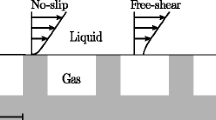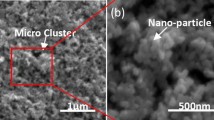Abstract
In turbulent flows over streamwise-aligned superhydrophobic surface (SHS) textures, the percent drag reduction is dependent on Reynolds number. This dependence is examined using direct numerical simulations of channel flow over SHS texture at three bulk Reynolds numbers, R e b = 2800, 6785 and 10975. Simulations of regular no-slip channel flows at the same bulk velocities are also performed for comparison. Changes in the flow due to the SHS texture are examined with particular focus on phase averaged statistics and coherent turbulent motions. As the Reynolds number is increased, the texture performance, or the percent drag reduction, is enhanced. In terms of turbulent motions, the weakened shear stresses are manifest as a decrease in the population of the small-scale vortical structures and a weakening of large-scale motions. The influence of stochastic fluctuations near the large-scale motions diminishes at higher Reynolds number. The enhanced performance is therefore due to a significant drop in the strength of small- and large-scale vortical structures. The weaker vortical motions yield a considerable reduction in the Reynolds shear stress and the transport of mean momentum. The SHS texture introduces a performance penalty in the form of a local increase in drag at the no-slip free-slip edge. This adverse effect is caused by the inhomogeneity of the near-wall flow field. However, the affected region narrows in width at higher Reynolds numbers. As a result, the percent drag reduction approaches the gas fraction of the texture.
Similar content being viewed by others
References
Cassie, A., Baxter, S.: Wettability of porous surfaces. Trans. Faraday Soc. 40, 546–551 (1944)
Daniello, R.J., Waterhouse, N.E., Rothstein, J.P.: Drag reduction in turbulent flows over superhydrophobic surfaces. Phys. Fluids 21, 085103 (2009)
Wenzel, R.: Resistance of solid surfaces to wetting by water. Ind. Eng. Chem. 29, 988–994 (1936)
Woolford, B., Prince, J., Maynes, D., Webb, B.W.: Particle image velocimetry characterization of turbulent channel flow with rib patterned superhydrophobic walls. Phys. Fluids 21, 085106 (2009)
Aljallis, E., Sarshar, M.A., Datla, R., Sikka, V., Jones, A., Choi, C.-H.: Experimental study of skin friction drag reduction on superhydrophobic flat plates in high Reynolds number boundary layer flow. Phys. Fluids 25, 025103 (2013)
Lee, C., Kim, C.-J.: Influence of surface hierarchy of superhydrophobic surfaces on liquid slip. Langmuir 27, 4243–4248 (2011)
Lee, C., Kim, C.-J.: Underwater restoration and retention of gases on superhydrophobic surfaces for drag reduction. Phys. Rev. Lett. 106, 014502 (2011)
Philip, J.R.: Flows satisfying mixed no-slip and no-shear conditions. J. Appl. Math. Phys. 23, 353–372 (1972)
Martell, M.B., Perot, J.B., Rothstein, J.P.: Direct numerical simulations of turbulent flows over superhydrophobic surfaces. J. Fluid Mech. 620, 31–41 (2009)
Martell, M.B., Perot, J.B., Rothstein, J.P.: An analysis of superhydrophobic turbulent drag reduction mechanisims using direct numerical simulation. Phys. Fluids, 22 (2010)
Choi, H., Moin, P., Kim, J.: Direct numerical simulation of turbulent flow over riblets. J. Fluid Mech. 255, 503–539 (1993)
Türk, S., Daschiel, A., Stroh, A., Hasegawa Y., Frohnapfel, B.: Turbulent flow over superhydrophobic surface with streamwise grooves. J. Fluid Mech. 747, 186–217 (2014)
Jelly, T.O., Jung, S.Y., Zaki, T.A.: Turbulence and skin-friction modification in channel flow with streamwise-aligned superhydrophobic surface texture. Phys. Fluids 26, 095102 (2014)
Park, H., Park, H., Kim, J.: A numerical study of the effects of superhydrophobic surface on the skin-friction drag in turbulent channel flow. Phys. Fluids 25, 110815 (2013)
Lauga, E., Stone, H.: Effective slip in pressure-driven stokes flow. J. Fluid Mech. 489, 55–77 (2003)
Ybert, C., Barentin, C., Cottin-Bizonne, C., Joseph, P., Bocquet, L.: Achieving large slip with superhydrophobic surfaces: scaling laws for generic geometries. Phys. Fluids 19, 123601 (2007)
Davis, A.M.J., Lauga, E.: Hydrodynamic friction of fakir-like superhydrophobic surfaces. J. Fluid Mech. 661, 402–411 (2010)
Zaki, T.A.: From streaks to spots and on to turbulence: exploring the dynamics of boundary layer transition. Flow Turbul. Combust. 91, 451–473 (2013)
Nolan, K.P., Zaki, T.A.: Conditional sampling of transitional boundary layers in pressure gradients. J. Fluid Mech. 728, 306–339 (2013)
Lee, J., Jung, S.Y., Sung, H.J., Zaki, T.A.: Effect of wall heating on turbulent boundary layer with temperature-dependent viscosity. J. Fluid Mech. 726, 196–225 (2013)
Lee, J., Jung, S.Y., Sung, H.J., Zaki, T.A.: Turbulent thermal boundary layers with temperature-dependent viscosity. Int. J. Heat Fluid Flow. 49, 43–52 (2014)
Hussain, A.K.M.F., Reynolds, W.C.: The mechanisms of an organized wave in turbulent shear flow. J. Fluid Mech. 31, 241–258 (1970)
Moser, R.D., Kim, J., Mansour, N.N.: Direct numerical simulation of turbulent channel flow up to R e t =590. Phys. Fluids 11, 943–945 (1999)
Min, T., Kim, J.: Effect of hydrophobic surface on skin-friction drag. Phys. Fluids 7, 55–58 (2004)
Fukagata, K., Kasagi, N., Koumoustaskos, P.: A theoretical prediction of friction drag reduction in turbulent flow by superhydrophobic surfaces. Phys. Fluids 18, 051703 (2006)
Busse, A., Sandham, N.D.: Influence of an anisotropic slip-length boundary condition on turbulent channel flow. Phys. Fluids 24, 055111 (2012)
Fukagata, K., Iawmoto, K., Kasagi, N.: Contribution of Reynolds stress distribution to the skin friction in wall–bounded flows. Phys. Fluids 14, 73–76 (2002)
Jeong, J., Hussain, F.: On the identification of a vortex. J. Fluid Mech. 285, 69–94 (2009)
Adrian, R.J., Christensen, K.T., Liu, Z.C.: Analysis and interpretation of instantaneous turbulent velocity fields. Exp. Fluids 29, 275–290 (2000a)
Adrian, R.J., Meinhart, C.D., Tomkins, C.D.: Vortex organization in the outer region of the turbulent boundary layer. J. Fluid Mech. 422, 1–54 (2000b)
Ganapathisubramani, B., Longmire, E.K., Marusic, I.: Characteristics of vortex packets in turbulent boundary layers. J. Fluid Mech. 478, 35–46 (2003)
Hutchins, N., Hambleton, W.T., Marusic, I.: Inclined cross-stream stereo particle image velocimetry measurements in turbulent boundary layers. J. Fluid Mech. 541, 21–54 (2005)
Monty, J.P., Stewart, J.A., Williams, R.C., Chong, M.S.: Large-scale features in turbulent pipe and channel flows. J. Fluid Mech. 589, 147–156 (2007)
Author information
Authors and Affiliations
Corresponding author
Rights and permissions
About this article
Cite this article
Lee, J., Jelly, T.O. & Zaki, T.A. Effect of Reynolds Number on Turbulent Drag Reduction by Superhydrophobic Surface Textures. Flow Turbulence Combust 95, 277–300 (2015). https://doi.org/10.1007/s10494-015-9627-z
Received:
Accepted:
Published:
Issue Date:
DOI: https://doi.org/10.1007/s10494-015-9627-z




